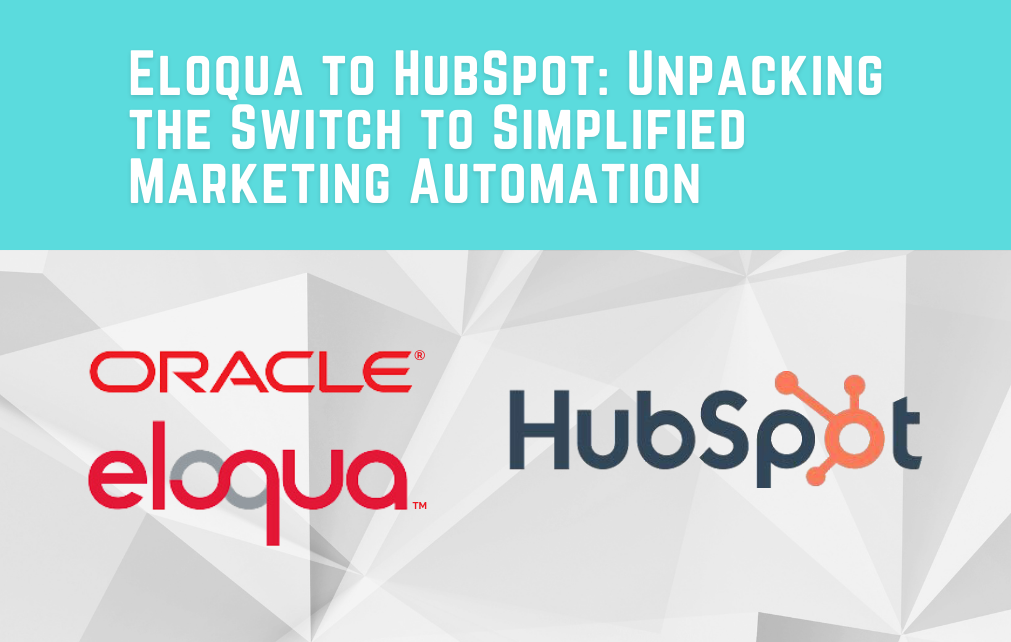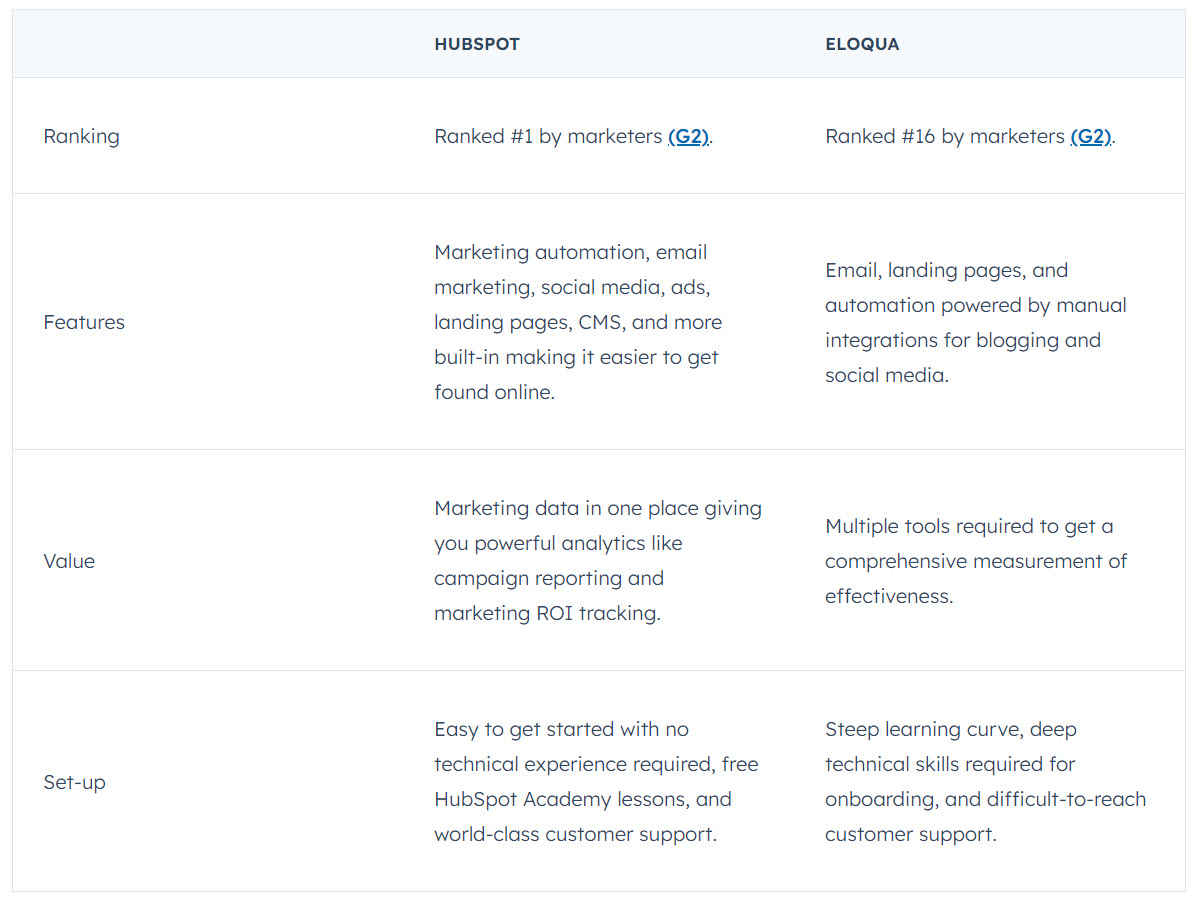4 min read
Eloqua to HubSpot: Unpacking the Switch to Simplified Marketing Automation
![]() Eddy Cervera
:
April 16, 2024
Eddy Cervera
:
April 16, 2024

Eloqua and HubSpot are two familiar names when it comes to marketing automation. Think of Eloqua, part of the Oracle family, as the go-to for big companies with complex organizational puzzles to solve. It’s all about deep customization, from super-detailed targeting to intricate campaign management. HubSpot, meanwhile, is like the friendly neighbor of the marketing world. It’s easy to use and brings everything – think content management, social media, SEO, email – together under one roof with other functions like sales and help desk.
So, why would anyone even think about moving from Eloqua to HubSpot? in our opinion, Eloqua’s great for the heavy-duty stuff for Fortune 500 consumer corporations, but HubSpot shines with its user-friendly vibe, all-in-one approach, and a serious knack for inbound marketing -- perfect in B2B companies of any size.This article dives into why moving from Eloqua to HubSpot could be your next big play. We’re talking about HubSpot's easy-to-use interface, its all-in-one CRM magic, clear-cut analytics, and how it might just be kinder to your wallet. Let’s unpack the reasons to switch from Eloqua and see if HubSpot is the right fit!
Eloqua vs. HubSpot: A Tale of Two Interfaces
When it comes to user interfaces, Eloqua and HubSpot are night and day.
Eloqua's interface is pretty robust, but it can be overwhelming or confusing, especially if you're not super tech-savvy. HubSpot's design is much more straightforward. Its intuitive design means you spend less time scratching your head and more time executing marketing campaigns.
For starters, its dashboard is easy to understand – you get a clear view of your campaigns, analytics, and tasks at a glance. And then there's a drag-and-drop functionality that makes creating emails, landing pages, and webpages a piece of cake to create. There's no need for a crash course in coding.
Plus, HubSpot guides you through its features with helpful tips and step-by-step instructions. This approachability is a game-changer for small businesses or teams without a dedicated admin. It’s all about making marketing easy to execute, not daunting.
HubSpot's Integration: Making Connections Effortless
One of the coolest things about HubSpot is how it plays so nicely with other tools and platforms. It's designed to work smoothly with a bunch of different systems. Whether you’re hooking up your CRM, email service, social media, or even customer service software, HubSpot makes the process simple. It has an entire library of built-in integrations, and setting them up is usually just a few clicks away. This seamless integration capacity is a time-saver and simplifies data management, ensuring all your tools are talking to each other without any tech headaches.
HubSpot's integration game is strong, particularly with some key platforms. Its CRM syncs seamlessly with popular systems like Salesforce without any complex workflows, ensuring your sales and marketing data are in harmony. Social media integration is another big win – you can manage and analyze your social media marketing directly within HubSpot, connecting platforms like Facebook, LinkedIn, and Twitter.
Email services like Mailchimp also link up easily, so you can coordinate your email campaigns and analytics without juggling multiple platforms (although not needed because HubSpot's email platform is strong). These integrations are not just about saving time; they're about creating a more cohesive and efficient marketing strategy.
HubSpot's Built-In CRM Capabilities: An Inside Look
HubSpot's built-in CRM system is a standout feature, offering businesses an all-in-one solution to manage their customer relationships effectively. It's designed to be both powerful and user-friendly, allowing users to track customer interactions, manage leads, and monitor sales pipelines effortlessly. The CRM integrates seamlessly with HubSpot's marketing, sales, and service hubs, providing a holistic view of each customer.
Eloqua, primarily a marketing automation platform, differs in its approach to CRM functionalities. Unlike HubSpot's built-in CRM system for marketing, sales, and help desk, Eloqua focuses more on marketing automation and typically relies on integrations with external CRM systems, such as Salesforce, to manage customer relationship data.
While this allows for powerful combinations and specialized functionalities, businesses might have to juggle multiple systems to get a complete picture of customer interactions. Eloqua's data sync can be challenging to manage if you are unfamiliar with it. Eloqua's strength lies in its advanced marketing automation capabilities, but for companies seeking a more integrated CRM experience within the same platform, HubSpot's built-in CRM offers a more streamlined and cohesive solution.
Analytics and Reporting: Eloqua vs. HubSpot
There are noticeable differences when evaluating the analytics and reporting capabilities of Eloqua and HubSpot. Eloqua, with its advanced automation focus, offers detailed analytics that are highly customizable. It excels in providing deep insights and complex reporting options that can be tailored to specific enterprise needs. However, this level of detail and customization might require a more skilled hand to navigate. HubSpot, in contrast, is designed with user-friendliness in mind. Its analytics and reporting features are more accessible, offering clear, easy-to-understand insights. This approach is particularly beneficial for businesses that want quick, clear data visualization without the need for extensive technical expertise.
HubSpot's analytics tools stand out for their ease of use and clarity, making data-driven decision-making more approachable for all levels of users. The platform provides a comprehensive overview of marketing, sales, and customer service data in a digestible format. This allows businesses to quickly identify trends, track campaign performance, and understand customer behavior without getting lost in overly complex data sets or programs. The simplicity of HubSpot's analytics means faster insights and quicker decision-making. This accessibility ensures that even those with minimal analytics background can make informed decisions, fostering a more data-driven organizational culture. The key to gaining these quick insights is to set up your Hubspot instance right the first time.
Overall, we agreed with HubSpot's summary. And it's hard to ignore HubSpot's latest G2 ranking.

Making the Transition
Switching to HubSpot from Eloqua brings several key advantages. HubSpot's user-friendly interface makes it accessible to users of all skill levels, streamlining the learning curve. Its seamless integration with various tools, including CRM systems and social media platforms, ensures a more cohesive marketing strategy. Starting with a free tier, the platform's pricing structure offers flexibility and cost-effectiveness, which is particularly beneficial for small to medium-sized businesses.
Additionally, HubSpot's built-in CRM capabilities provide an integrated approach to managing customer relationships, while its analytics and reporting tools offer clear, actionable insights for data-driven decision-making. These factors combine to make HubSpot a comprehensive, efficient, and user-friendly marketing solution.
For companies contemplating shifting from Eloqua to HubSpot, it's an opportunity to streamline your marketing efforts and embrace a more integrated, user-friendly approach. The transition may require planning and adaptation, but the long-term benefits of a more cohesive, user-friendly, and cost-effective marketing strategy are compelling.
HubSpot's supportive ecosystem and wealth of resources will guide you through the change, ensuring a smooth transition. Embrace the change, and you may find that HubSpot meets and exceeds your marketing needs, driving growth and efficiency in your business strategies.
Real-life Migration from Eloqua to HubSpot
Want to see an Eloqua to HubSpot migration in action? Check out our new case study outlining our work for a digital staffing provider. In it, you'll learn:
- Strategic Planning: How we assessed what was required into effective migration strategies and the critical roles of stakeholders.
- Technical Solutions: Details on overcoming technical challenges during the data and workflow transfer.
- Transition Benefits: Highlights the benefits of moving to a more user-friendly platform.
